Text


Leucospermum reflexum
Leucospermum is a genus in the Protea Family, heavily concentrated in the winter-rainfall region in western South Africa. They are often called "pincushions" because of the way their long stigmas protrude from the flower cluster. Leucospermum reflexum is unusual in the way that the stigmas (the "pins") extend downward, suggesting a rocket blasting off - hence its common name of "rocket pincushion". It comes from the Cederberg, a sandstone mountain range to the north of Cape Town.
-Brian
27 notes
·
View notes
Text
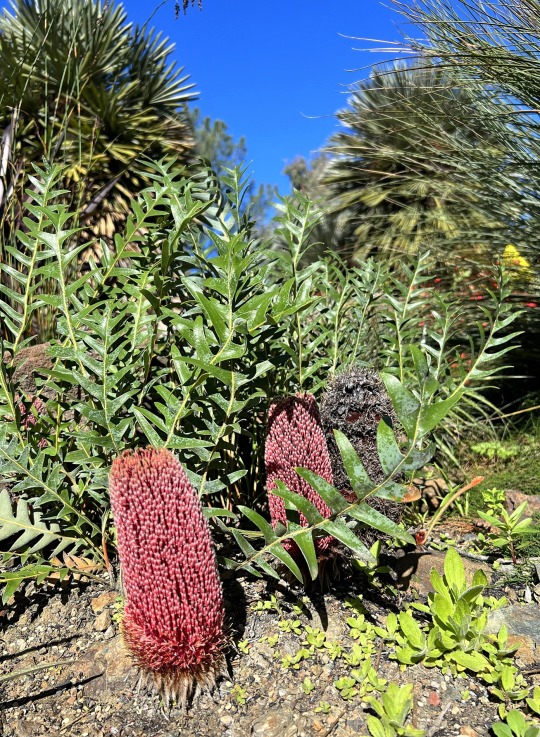

Banksia blechnifolia
Banksia is a large Australian group in the Protea Family, with many species found in the winter-rainfall region of Western Australia. Banksia blechnifolia comes from the province's south coast, and it is one of the species with a creeping prostrate growth habit, unlike most of its shrubbier relatives. In the lower picture, the new flower head is on the left, and the old one (with its reddish-brown seed-containing follicles visible within its grayer column) on the right.
-Brian
20 notes
·
View notes
Text
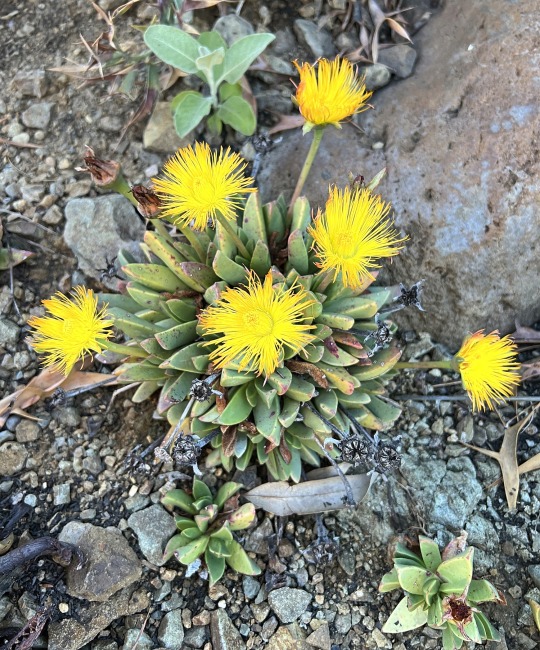

Machairophyllum sp.
Machairophyllum is a small genus in the Aizoaceae, or Ice Plant Family, mostly native to the Little Karoo region of South Africa, which is home to many succulents. The plant pictured came without a name, but it originates in the Witberge mountain range, to the north of the western end of the Little Karoo. The bright yellow flowers, with many narrow petals, open at dusk.
-Brian
24 notes
·
View notes
Text
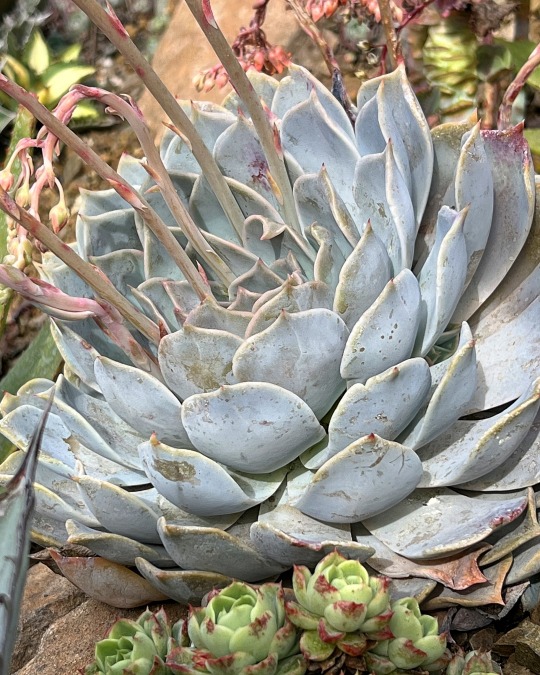
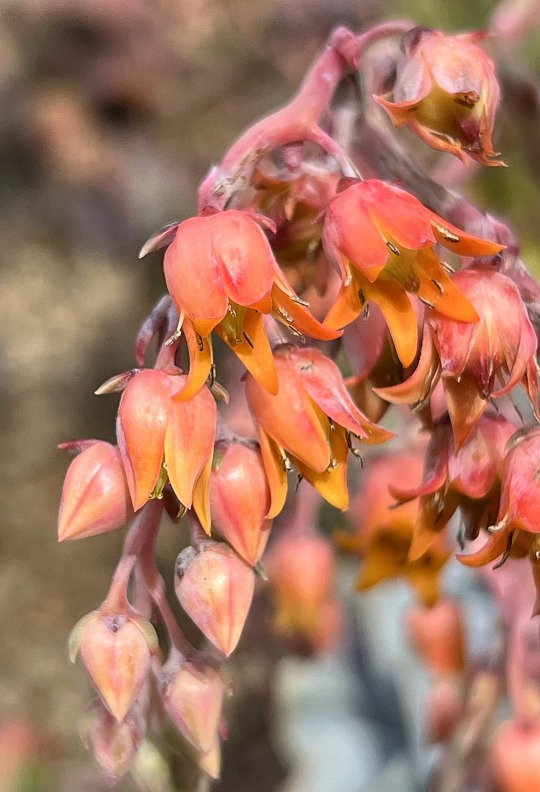
Echeveria 'Padma'
This beautiful Echeveria hybrid was created by Walker Young, the Assistant Curator at the Ruth Bancroft Garden. It has 3 species in its parentage: Echeveria lilacina, Echeveria colorata and Echeveria agavoides, most closely resembling the first of these. The glaucous rosette and orange flowers are a wonderful combination. All the plants in its parentage are native to Mexico.
-Brian
27 notes
·
View notes
Text

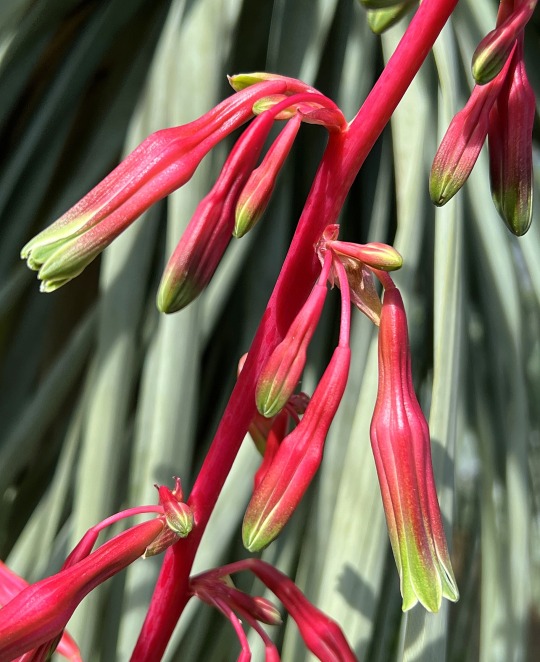
Beschorneria septentrionalis
Beschorneria is a small Mexican genus related to Agave, with plants typically fond in the mountains in forested areas, rather than in the drier lowlands. The most commonly grown species is Beschorneria yuccoides, but B. septentrionalis is a smaller plant with vivid green leaves, rather than glaucous-green like B. yuccoides. The flower stalk of B. septentrionalis is also a brighter red, and it remains attractive all the way through to the end of the summer as the large fruits develop. It does well in semi-shade (or in full sun in cooler coastal climates), and it is quite cold-tolerant to as low as 10° F (-12° C).
-Brian
16 notes
·
View notes
Text


Aloe rupestris
This Aloe comes from northeastern South Africa, as well as neighboring Eswatini and also southern Mozambique. It is one of a group of aloes with candelabra-type inflorescences, bearing multiple branches holding elongated clusters of tightly-bunched flowers. Among these, it is unique in having short yellow-orange flowers that are almost hidden from view once they open and the long reddish stamens and pistils extend out from them. It is a stunning sight, but not a long-lasting one, since this species tends to flower in a hurry, going from start to finish in only a few weeks.
-Brian
19 notes
·
View notes
Text
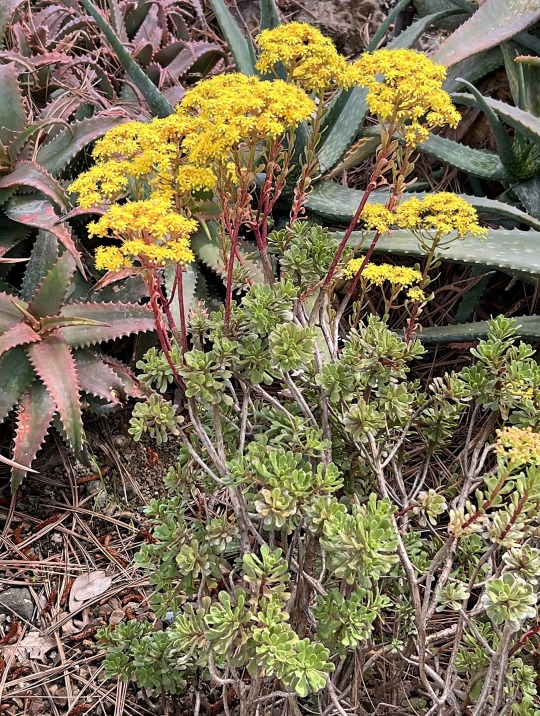
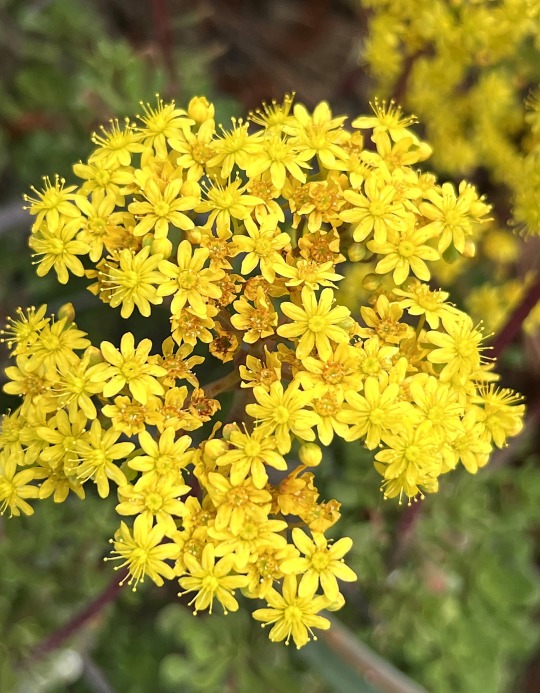
Aeonium spathulatum
Aeoniums are members of the Stonecrop Family (Crassulaceae), with most of the species native to the Canary Islands, which are part of Spain and located in the Atlantic Ocean off the coast of Morocco. Aeonium spathulatum is found on several islands in the group, and it has small, spoon-shaped succulent leaves and clusters of bright yellow flowers in spring. It is very much adapted to winter rainfall, and it tends to look dry and shriveled in the summer months, after it has bloomed.
-Brian
24 notes
·
View notes
Text


Drosanthemum micans
Drosanthemum is a genus of about 60 species in the Ice Plant Family (Aizoaceae), most of them found in the winter-rainfall area in western South Africa. They are often very enthusiastic flowerers, as can be seen here - the plant itself completely hidden by its flowers. The vivid red and yellow of the flowers makes for a very festive spring display. D. micans is native to the Robertson Karoo, a relatively dry region to the east of Cape Town.
-Brian
30 notes
·
View notes
Text

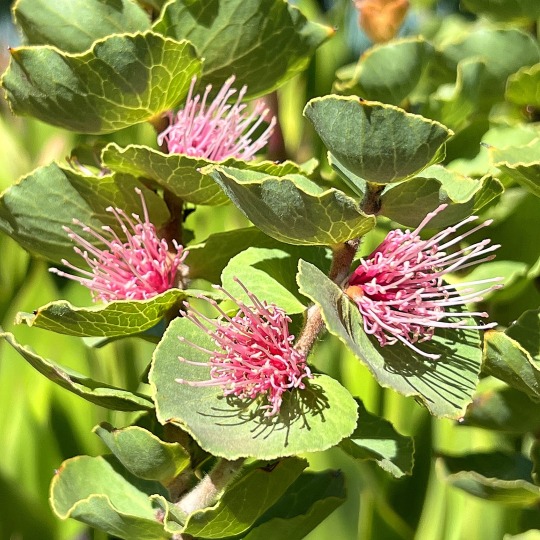
Hakea cucullata
Hakea is a large genus in the Protea Family native to Australia. Though different species are found in various part of the country, the greatest concentration occurs in the southwest, in the winter-rainfall region. This is true for Hakea cucullata, which comes from the south coast of Western Australia, to the southeast of Perth. It is a large shrub, eventually attaining a height of up to 13 feet, or 4 m. The clusters of pink flowers, with extended stigmas, are not large, but they are quite attractive - and all the more appealing for they way they are cupped by the rounded wavy-edged leaves.
-Brian
40 notes
·
View notes
Text


Echeveria 'Lime n' Chile'
This compact Echeveria hybrid combines green rosettes with short flower stalks bearing fiery flowers. It offsets to form a cluster of heads, and makes a colorful display of flowers in spring. An introduction from Altman Plants.
-Brian
81 notes
·
View notes
Text
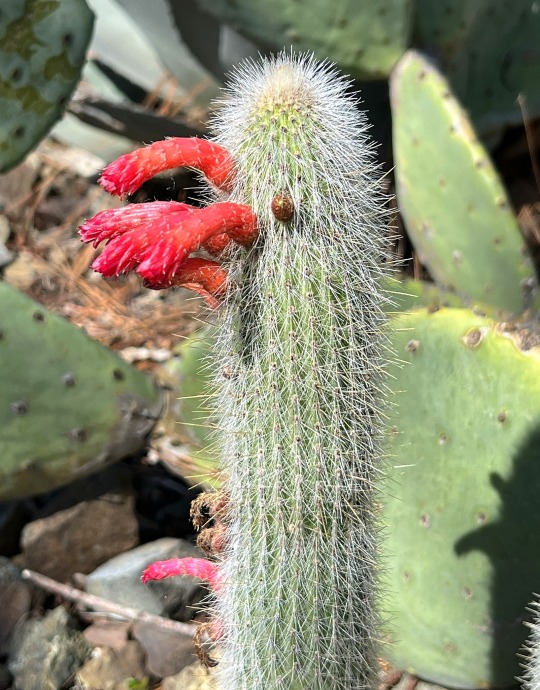

Cleistocactus hyalacanthus
Cleistocactus is a genus of generally slender-stemmed columnar cacti from South America. While many of the species start out growing erectly, but then sprawl to the side as they elongate, Cleistocactus hyalacanthus is one of those that keep to an upright growth form, making a cluster of shaggy columns. The spine color ranges from white to yellowish-brown. This species is similar to C. strausii, but its flower color is more pinkish-red (as opposed to the more purplish-red color of C. strausii, which also has longer flowers). The tubular flowers, attractive to hummingbirds, are a notable feature of the genus. C. hyalacanthus is native to northwestern Argentina.
-Brian
18 notes
·
View notes
Text

Pachyphytum bracteosum
Mexico is home to a large assortment of wonderful succulents belonging to the Crassulaceae, or Stonecrop Family. Among these, the species in the genus Pachyphytum are notable for their cartoonishly balloon-like leaves, often with pallid pastel colors. They usually grow on rocks (often on sheer cliffs), and they have inflorescences that nod at the tips, like a scorpion's tail. This one is Pachyphytum bracteosum, and although it has red flowers, these are almost hidden by the fleshy pale-green sepals that clasp them. From the state of Hidalgo.
-Brian
35 notes
·
View notes
Text
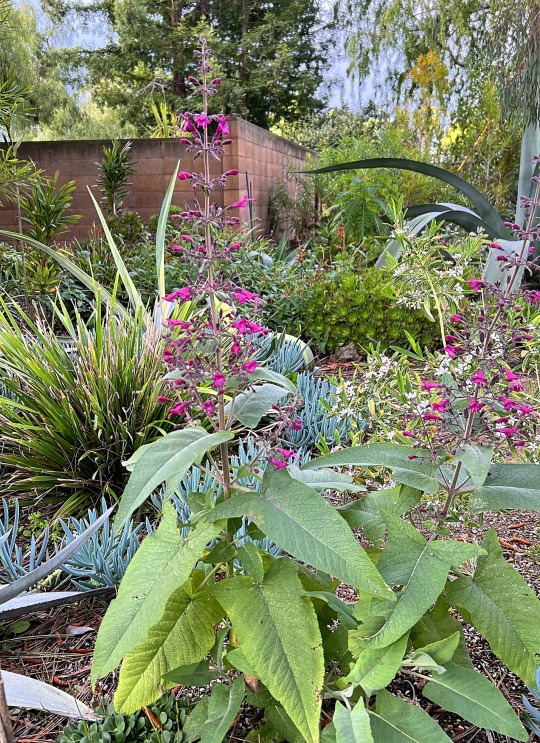
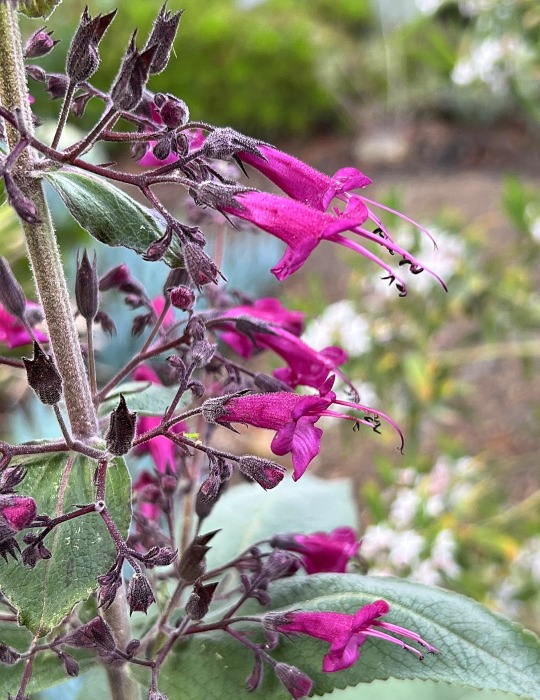
Lepechinia hastata
Lepechinia is closely related to Salvia, and the plant pictured looks much like a Salvia, with its fuzzy squarish stems and its whorls of flowers. Lepechinia hastata comes from the Baja California peninsula, and it is sometimes called the Cape pitcher sage. It belongs to the Mint Family (Lamiaceae).
-Brian
19 notes
·
View notes
Text


Kniphofia cultivar
Kniphofias are part of the Asphodel Family, and they come from Africa. They have been hybridized by gardeners for centuries, and many of the available cultivars have Kniphofia uvaria in their parentage. The plant pictured was received without a name, but it is fairly typical of those seen in gardens, with its dense racemes of narrow tubular flowers and the striking contrast between the darker color of the buds and the lighter color of the open flowers.
-Brian
11 notes
·
View notes
Text


-Gasteria pulchra
Gasteria is closely related to Aloe, but it is a smaller genus with a more limited area of occurrence, since all the species come from southern Africa. All the species have dangling flowers shaped like a comma, and typically the swollen base of the flower is in the red-to-orange range, while the mouth is striped. Gasteria pulchra is notable for its tall inflorescence with widely diverging floral branches, as well as its small flowers and its smooth, narrow spotted leaves. From west of Port Elizabeth in South Africa's Eastern Cape Province.
-Brian
16 notes
·
View notes
Text
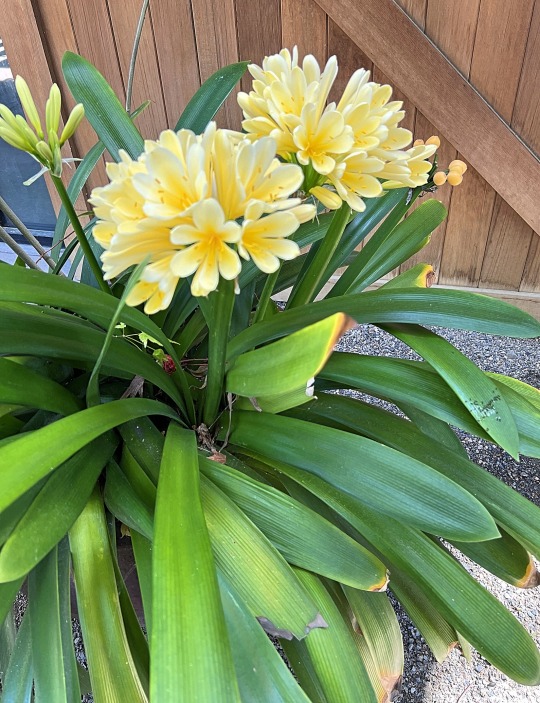

Clivia miniata
This evergreen bulb comes from eastern South Africa and adjacent Eswatini. The usual flower color is orange, and when yellow forms first found their way into horticulture, they were quite expensive. By now, though, they are easier to come by. Clivia is a genus in the Amaryllis Family, and Clivia miniata is the most widely grown species.
-Brian
33 notes
·
View notes
Text
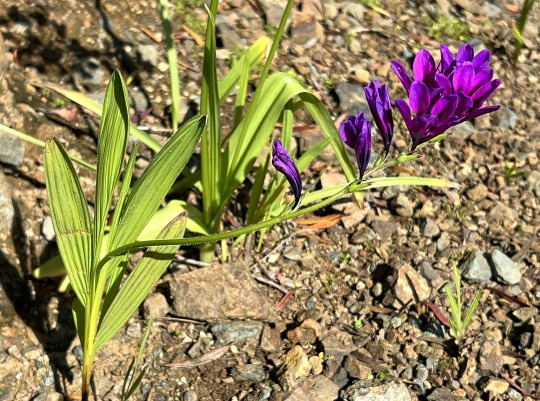

Babiana sp.
We have lots of plants in the genus Babiana at the Ruth Bancroft Garden, some of them without names, as is the case with this one. They are part of the Iris Family, and mostly native to western South Africa. Blues and purples dominate in the flowers of this group, and they are at their peak in early spring.
-Brian
7 notes
·
View notes